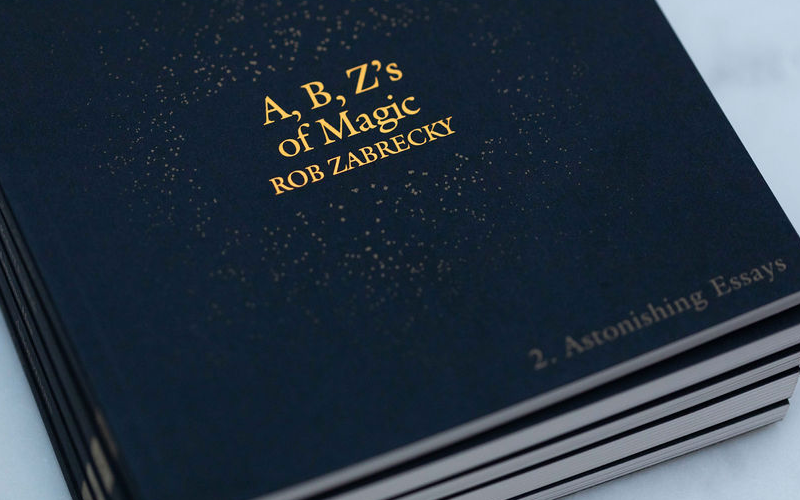And now, the second half of, “A Rave of Reviews.” Jamy Ian Swiss covers two books and one essay series highlighting three parts from that series. Needless to say, there is much to discuss, so without any further delay…
The Buena Vista Shuffle Club
By Matt Baker
While Scripting Magic 2 from Part 1 of this article, has been in my hands for…[checks emails]…almost two years, ack! … (sorry, Pete!)…I only just received this new book from mathematics professor and avid amateur magician Matt Baker. This is my first encounter with Mr. Baker’s work and I found his book an originally conceived and well-executed pleasure to read.
Part of that original conception is that each routine is followed by a conversation between the author and several imaginary friends, not named Rigonally, Khardova, and Faxton, but rather, Dev, Bernie, and Ray, who comprise a kind of ongoing brainstorming session, representing somewhat differing lines of thinking, taste and performance inclination. It’s an engaging and fully realized conception, odd as it may sound here in all-too-curt summary form, and contributes mightily to lending the book its distinctive flavor.
In the opening pages, the author sets out some introductory thoughts about his own personal tastes in both magic and magic literature, and about to what tastes his book is most (and least) likely to appeal. It’s a fair and honest assessment, which serves to provide a reasonable summary assessment of the contents. Here Professor Baker states his affection for “memorized deck, work, and the entire first part of the book is devoted to exploring new possibilities for this tool. The second part of the book explores non-card magic…there are two mentalism routines as well as some easy-to-perform routines with coins. Part Three is devoted to card magic which does not require a memorized deck.”
He further adds that he is interested in “fresh presentations…new methods, and…original plots…and in this book you’ll find my explorations of all three.” He goes on to write that “If you’re mainly looking for impromptu card effects, this book is probably not for you. ….If you’re looking for highly visual magic, this book is also probably not for you. My magic tends to appeal more to the mind than to the eyes. It’s primarily card magic, frequently with some kind of mathematical principle happening in the background.”
While I don’t mean to simply quote the author’s work to serve as a substitute for my own review, this kind of frank and straightforward self-assessment is a rare thing, particularly in the swamp of hype the magic market now finds itself drowning in daily. And I’ll confess that this appraisal, to some extent, inadvertently points to certain differences between the author’s tastes and my own. But I would be remiss if I failed to include this concluding observation from the good professor, to wit: “In addition to filling the book with what I believe is strong magic, I’ve tried to make the book fun to read. I love reading magic books with a personality, and don’t seem to have much patience these days for books that are straightforward compendia of tricks. I’ve always believed that you should write the kind of book that you yourself would like to read, so here you are: a book written by me and for me.”
I’ve included those words here because it is my sincere wish that more writers and publishers of magic literature would seriously consider the point before flushing their work down the magic product and publishing sewer. I’ve also included those words because they speak to a key element that contributed to my enjoyment and recommendation of it for other likely readers. And now, thanks to the author, you already know who you are.
While in general I’m not a fan of tricks requiring elaborate setups, card tricks requiring thoroughly gaffed decks, methods that rely on math or extended procedure, and effects that lack significant visual components—despite all that, I found examples of each of those categories in this book that have merit and appeal. Another kind of magic I typically have little interest in is magic designed to fool “well posted” magicians. That doesn’t mean I don’t think about fooling magicians; I do, and I like it when it happens. But I don’t design material with the primary intention of performing it for magicians who will recognize the plot and method and then attempt to fool them above and beyond that knowledge, because I have little interest in performing for such audiences. There’s no shortage of this kind of material in the magic literature, and it’s not created for me.

That said, within this volume there is included, among other examples of such intent and material, a version of Simon Aronson’s “Shuffle Bored” that will, thanks to a methodological addition, not only fool most magicians—even those who do the trick—but is also accompanied by an original presentation that, for me, makes a great deal of sense of the routine, lending a somewhat different approach to the plot. Shuffle Bored is often performed as a prediction—an approach I find far less interesting them presenting some kind of real-time magical determination—but be that as it may, Professor Baker has attached something believable and engaging, that whether or not you apply his diabolical approach to the handling, may well appeal to experienced performers of the original Aronson routine.
There have been a number of routines published over the years intended to restore a shuffled deck to a stack or half-stack order. Often these routines deliver more in function than in magical quality, but with “Elementary, My Dear Vernon,” the author provides a routine that is deceptive and entertaining, while accomplishing the useful goal of secretly assembling twenty-six cards into a known order. At the risk of stating the obvious, a further application here is that if one begins with a half stack in play, this trick can be used to completely restore the remainder of the deck to full memdeck order. Nice!
In the full gaffed deck category, “Outlier” presents a very clear and impossible effect, wherein the spectator names any card, and then proceeds to mysteriously find one card that turns out not only to be her own selection, but is also the only such card in a deck of 51 all alike cards of a different identity.
There is a fun platform routine based on the theme of the board game Clue. I’ve always thought this would be an excellent premise for a mental magic routine, as a divination or prediction, and the author provides a prediction approach that has lots of opportunity for an entertaining performance. This routine, co-created with Dan Garrett, was originally conceived as a two-person performance piece, and also utilizes ideas from another routine of Andi Gladwin’s, that did not involve the Clue plot. The author has transformed these elements into a commercial piece of standup mental magic.
Also in the close-up but non-card arena, there is a nice presentation for a coin assembly (a la Matrix and Reverse Matrix), tricks that are typically difficult to present without weighing the magic down with too much verbal freight.
Those are just a few examples from a collection of twenty routines. Throughout, every routine, and the ensuing discussion amid the Shuffle Club members, is laden with extremely thorough credits, which both source the elements, and lead readers to discover an array of current ideas, publications, and products, that they might not otherwise be familiar with. I certainly found this to be true a number of times, since the author doesn’t mind accumulating a variety of commercially available…stuff…to help him assemble and achieve some of his methods. Even though, once again, this isn’t always to my own taste, I enjoyed being exposed to his awareness of the current zeitgeist of clever methods and products available to the thinking creator and performer.
In yet another appealing and well-conceived addition, the book concludes with a ten-page “Quick Reference Guide” that summarizes each routine, including its effect and “considerations” concerning method or other useful details. Finally, the author includes a web address that provides readers with performance videos of many of the routines, including performances taped at Fechter’s Finger Flicking Frolic, and at a workshop in Spain led by Juan Tamariz, to which the maestro personally invited the author. The site also has useful tools available for download, including a great poster-as-prediction to reveal as the finale to the Clue routine, designed by the author’s daughter, Joanna.
So if you meet the brief of the author’s opening caveats, then you are likely to find something useful and enjoyable in these pages. And if you only fulfill part of that brief—and are mostly looking for a smartly conceived and well-written book of magic—you’re likely to enjoy it as well.
The Buena Vista Shuffle Club by Matt Baker. 6” x 9” hardcover with gold foil stamping, coated color dust jacket; 264 pages; illustrated with 45 black-and-white photos; 2019. Published by and available from the author, $50

Astonishing Essays from Vanishing Inc.
-
A, B, Z’s of Magic by Rob Zabrecky
-
Diary of a Prison Magician by Joshua Jay
-
The Trickster Spirit by Robert E. Neale
In 2018, Vanishing Inc. began publishing a series dubbed “Astonishing Essays.” These comprise a planned series of single-volume essays in a distinctive format: elegantly produced, softbound booklets, running generally between fifty and a hundred pages each. This is another worthy project in Vanishing Inc.’s approach to publishing, which reflects a genuine passion for books, and an encouragement of reading that doesn’t always seem to be driven solely by a demanding focus on the bottom line.
In case there’s any confusion, I intend that as a compliment. Another fine example in this realm, in addition to the Astonishing Essay series, is Andi Gladwin’s wonderful reissued edition of The Card Magic of Edward G. Brown, which I have previously reviewed in the Lyons Den. (In the interest of full disclosure, my own three books published by Vanishing Inc. might well fall into this pride-over-profit model.)
While it’s not my intention in this Rave of Reviews to review every installment of the Astonishing Essay series in any detail, I will briefly draw your attention to several of my favorites. A, B, Z’s of Magic by Rob Zabrecky is Number Two in the series, and I enjoyed it immensely. Zabrecky should require little, if any, introduction to readers here, and this uniquely offbeat and original performer has based this essay on a lecture that led to his being awarded Lecturer of the Year by the Academy of Magical Arts (Magic Castle) in 2016.
The author explains in his introduction that, “throughout my performing career, I’ve made it part of my crusade to demystify the creative process.” In this effort, he created the award-winning lecture, from “material gleaned from over twenty years of obsessive personal research, listening and talking with all types of magicians about what makes special magic acts so special, and ordinary magic acts so forgettable.”
And thus he presents us with his Alphabet guide, utilizing each letter of the alphabet to discuss a guiding principle in his pursuit. From A for Acting to Z for—well, Zabrecky…what else?—he provides a cogent manual that amateurs and professionals alike, of varying degrees of experience and proficiency, are likely to find informative and thought provoking.
I loved reading his thoughts on acting, and his adaptation of Uta Hagen’s questions for actors, transformed into important questions for magicians. A lengthy entry on Practice & Preparation includes a detailed script drawn from his own work, for a routine that many readers will have already seen him perform, which comprises a cogent lesson in scripting, attention to detail, and preparation. This entry could serve as a fine companion piece to McCabe’s Scripting Magic set.
The letter Q stands for Questions, and the author proposes some essential ones, that every performer needs to ask and answer for him or herself. The essay—this essay as well as the entire essay that comprises the booklet—is short. Zabrecky provides the questions, but it’s up to the student to use them as stimulus and inspiration to go out and seek the answers for themselves. The booklet is brief, and one longs for a fully fleshed out examination of the author’s thoughts and ideas. But nevertheless, it is a useful work even in such abbreviated form.
The third entry in the series is Diary of a Prison Magician by Joshua Jay, who is, among other things, one of the two founders of Vanishing Inc. In his introduction to this piece he explains that, “Several years ago I received a letter postmarked from a prison in California. The letter was blunt; the writer was serving a life sentence for a serious crime (that he maintains he did not commit). He was also a magician; he wanted to chat magic. Four years later, I still regularly correspond with this person, who wishes to remain anonymous for his own protection…”
Protection from what? As magicians and live performers we all know that there is much at stake every time we take the stage and present an illusion. We face failure, challenge, exposure, and other threats that at times feel potentially mortal; even though, as Teller says, “Nobody ever died over the secret to a magic trick.”
Well, yeah.
But Josh continues:
He’s been shaken down by authorities when he wouldn’t tip his magic. He has been assaulted for keeping secrets. And he has had, without notice, all his magic confiscated from him by authorities out of spite. Yet through it all, this is actually a tale of perseverance. Magic has given him hope and purpose, and it has spread joy in a place where there is little of it.
It’s fair to say that this little booklet comprises an essay that is truly astonishing. It has been assembled and constructed by Josh Jay, but it is written by his anonymous correspondent. Some of my favorite books in magic are those that tell compelling first-person stories; David Bamberg’s Illusion Show: A Life in Magic comes immediately to mind. This little essay is, obviously, not as substantive a tale. But it may well be as memorable, and affecting.
Consider this excerpt:
If you love something, you will find a way to do it. If you truly love it, you’ll find a way to do it well. Whenever I perform magic, I put my all into it. If I didn’t, I’d just be “the guy who does magic tricks.” Easily forgettable. Nobody wants to be forgotten. I’m no different. I want to be remembered. Not for the wrong reasons. I know over the years I’ve done magic for guards and inmates alike that they are still talking about. That’s the beauty of something done well. It can become a memory of something amazing.
Really, what more can I say?
You may not know it, but trust me: you want to read this piece.
Finally, the fifth work in the series is The Trickster Spirit by the inimitable Robert Neale. I’m a longtime fan of Bob Neale’s distinctive writing and thinking, and even in this little essay he stands out as a truly singular being. In order to provoke the reader into thinking in new ways about him or herself and his or her work, play, love, and life in magic, he retells, based upon prior sources, three parables of “The Trickster, our guide and muse.” As Neale writes in the opening pages: “What Trickster does is make mischief with meaning. This is the lesson.”
Like so much of Neale’s oeuvre, this is not a direct path to what he wishes to show us, and wants us to think about. Hence some will read this little booklet and come away largely perplexed, and unclear on the lesson and purpose. But all I can say is: I think I got it! And Neale’s three fables are stories—I think—that are intended to remind us that magic is, at its foundation, a form of adult play.
In my earliest, original magic lecture, circa 1987, I often said—now that I am reminded of it—that magic is a form of adult play, in a world in which many adults have forgotten how to play. Because real play is not passive—it’s not sitting on the couch, beer in hand, watching television. Genuine play is active, interactive, and above all, creative. But our culture often trains us to forget this fact, and reinforces the dreaded and tragic belief, to the degree of it becoming an operative life assumption, that play is something best left to children.
But that’s not the only sad and wrong-headed idea we have about play. We are also often encouraged to think that play requires competition. Beating a business colleague’s brains out on a squash court is considered play by some members of our species. I am not one of those members.
Magic is—can be—an exquisite, and fabulously adult, form of play. A form in which people on both sides of the equation, the performer and the audience, are engaged, with their minds, their emotions, and their creativity, in a kind of mutually shared playtime. I think Neale gifts us with his three parables as a reminder of this, and other important lessons about our art.
Thanks, Bob.
Astonishing Essays from Vanishing Inc., and available from the publisher: A, B, Z’s of Magic by Rob Zabrecky. 6” x 6” softcover; 66 pages; 2018. $25 | Diary of a Prison Magician by Joshua Jay. 6” x 6” softcover; 105 pages; 2018. $25 | The Trickster Spirit by Robert E. Neale. 6” x 6” softcover; 97 pages; 2018. $25.
To Your Credit
By Harapan Ong
As the writing of this piece was drawing to conclusion, I came upon a brand-new e-book, small in size but grand in vision and importance, which I am compelled to bring it to my readers’ attention.
In the past, Vanishing Inc. has published e-books that they have, remarkably, offered as free downloads. Most notable of these, I think unarguably, is the massive volume of theory essays entitled Theory in Mind, collected by Joshua Jay, which include essays by Tommy Wonder, Juan Tamariz, Rene Lavand, John Carney, and a host of other contributors (including this writer). If you don’t have it, there is no excuse; you can get it for free.
The publisher’s newest addition to this select list of free publications is a marvelous eighty-two-page e-book by the inventive young magician, Harapan Ong, entitled To Your Credit. Remember how I mentioned the excellent and important crediting that Pete McCabe provides in Scripting Magic 2? Well, now Harapan Ong cogently explains both why and how you should and can do the same when discussing and writing about magic.
I’ve been writing about the importance of proper and responsible crediting in magic, along with the issue of theft of material, since my first lecture notes in 1987 (ref: Theatrics) and in my books, beginning with an essay in Shattering Illusions entitled “Odometer Ethics,” that appeared in the original essay series in 1994. In all those years and the many years and words since, I don’t think I’ve ever come across such a lucid and thoroughly useful a piece of work about these subjects than this new e-book. In it, the author asks, and succinctly answers, and addresses, the following questions and subjects:
- Why is crediting important?
- If crediting is so important, why is it so hard to do?
- What do I have to credit?
- Public domain
- Where can I find information for crediting?
- Essentials of crediting
- Crediting: going further
- Formatting
- Permission
- Why publish?
- So, when is permission actually necessary?
- How similar is too similar?
- But what if they say no?
- Independent invention
- How to deal with independent inventions
- What if I discover someone has ripped me off?
- How to deal with other crediting mistakes
Have you ever wondered about any of these questions and issues? Moreover, have you ever published, or are you thinking about or intending to publish, without first carefully considering each and every one of these questions and issues?
If you answer “yes” to even one of these, you need this booklet. And it’s free. And I’ll tell you what: The entire community of magic creators, producers, marketers, writers and publishers owes a huge debt of thanks for its existence.
I will add that there’s not much of anything I can find to disagree with in this e-book. My feeling about claims of “independent invention” is less sanguine than the author’s, based on my personal experience, but that doesn’t change my agreement with his recommendations about the subject. Also, I would have included a table of contents, which in effect I have just provided above, to serve as a useful reader’s tool.
But these minor thoughts and suggestions aside, without reservation, to Harapan Ong, I respectfully declare the publication of To Your Credit to be ever so much to your well-deserved credit, sir. Well done, and thank you for it.
To Your Credit by Harapan Ong. Ebook; 83 pages; 2019. Published by Vanishing Inc. Available for free.
Lyons Den Collection






